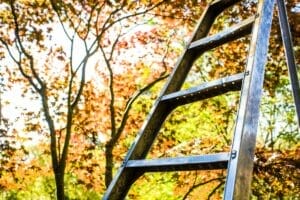 Albert Camus famously wrote, “Autumn is a second spring, when every leaf is a flower.” There’s no denying that Portland is a great place to enjoy the “second spring,” as many local trees put on spectacular shows of changing color. However, trees that change colors too early may be stressed. While providing Portland tree care, we are often asked about early-changing leaves, and how to help stressed trees. Read more if you would like to find out what you can do about helping distressed trees that are changing their colors too early.
Albert Camus famously wrote, “Autumn is a second spring, when every leaf is a flower.” There’s no denying that Portland is a great place to enjoy the “second spring,” as many local trees put on spectacular shows of changing color. However, trees that change colors too early may be stressed. While providing Portland tree care, we are often asked about early-changing leaves, and how to help stressed trees. Read more if you would like to find out what you can do about helping distressed trees that are changing their colors too early.
Premature color change is a strong sign that your tree is distressed. Early color change can be quite common after a long, hot summer, such this past summer. Untimely color change can indicate that a tree is not vigorous enough to protect itself from insects or disease, nor the challenges of wet, cold winter weather. If one or two branches turn colors early, this could mean that those braches are diseased. Removal of the diseased branches should help, but if the entire tree is showing colors early, this could be a sign of a root-related problem.
Fluctuating weather patterns with variations in the amount of rainfall, temperature, and sunlight can also cause leaves to turn colors early. Some plant biologists see early color change as a natural adaptation to pests, especially those that feed on the juices of the succulent leaves. By changing color, the tree is able to break down chlorophyll and direct energy away from the leaves. Insects find that there is nothing left to eat, and so they move on to the next tree.
Certain species have their own reasons for changing colors early. Maples often turn red too early, for instance. Oftentimes, this is due to branch dieback, but it could also indicate a nitrogen deficiency. Ultimately, a tree changes color early as a defense mechanism to save or divert energy, or to combat more serious pest problems.
If you see any of the problems mentioned above, be sure to give your trees an inspection for signs of injury. Perhaps the tree sustained damage in the hot, dry summer. Or perhaps you inadvertently brushed the tree with a lawn mower. In any case, it’s a good idea to closely inspect your trees regularly to ensure that you notice any damage as early as possible.
Consult an Arborist. An ISA-certified arborist is trained in identifying tree problems and can offer a number of solutions. If you are unsure if your trees are healthy or not, it might be a good time to call a professional. Our Portland certified arborists are happy to advise you on a number of tree-related topics, such as caring for new plantings, monitoring for soil deficiencies, checking and managing pests, and all other Portland tree services.